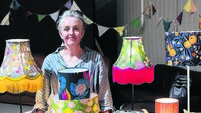A night out with Gina that left me pondering women and art

I’m not talking about sitting down to a production of Grease or an earthy John B Keane drama. That sort of fare is generally safe because experimental theatre-makers wouldn’t be arsed trying to make such material thrillingly provocative. (John B’s work can be quietly provocative, showing up Irish society and its hypocrisies in the bad old days.)
But sometimes, heading out for the evening to be entertained and/or provoked, you have no idea what lies ahead.
Described as “a wildly funny and immersive performance” from her, it wasn’t a play as such, more a site specific installation that took place across various spaces in the Crawford Art Gallery.
In the gallery’s lecture theatre, Gina soft-soaped the audience (mainly female) with her mimicry of Cork people who often ask her: ‘Are you up in Dublin the whole time now?’ Nothing personal, Gina said. She’s been ‘up there’ since completing her studies at the Crawford in the late 1970s. Yes, she started out as a visual artist before turning her talents to theatre.
Then she got down to business with her ‘restoration comedy’, an attempt to right the wrongs of the official history of art that is in fact more than six centuries of male art as written in a book entitled The Story Of Art, studied by art students over the years.
First published in 1950, the book is described as a seminal work of criticism. Thankfully, The Story Of Art Without Men was later written by German artist, Katy Hessel, putting women back in the picture, so to speak.
In the lecture theatre, Gina uttered profanities and admitted to banging the same old drum.
A soprano belted out the names of more than 100 female artists. It was impressive. Among the Irish artists mentioned were the likes of the renowned Shandon-based Maud Cotter and leading contemporary Irish artist, Alice Maher, who attended the Crawford.
That was all very cool and worthy. Yes, we needed reminding that there are absolutely loads of female artists expressing themselves in a world that can still be a little chilly towards women.
Ramping up the show/installation/immersive experience, Gina led us to other spaces in the art gallery, including the sculpture room.
She admitted that she didn’t pursue visual art as a career as she didn’t think she was good enough. (How many men would make such an admission?).
But that didn’t stop Gina from seriously criticising the way art has been presented as the preserve of men, with women maybe featuring as muses.
She announced that we were going to perform an ‘art attack’. Art can bring up various emotions including joy, sadness and anger. It can also lead to mental or physical symptoms after an encounter with a piece of art. Officially called ‘Stendhal syndrome’, it’s considered a psychosomatic disorder.
While rare, it was first described in 1989 by an Italian psychiatrist. Another name for the condition is aesthetic sickness.
Gina had dancers on board that skipped around, handing each of us a ball of shocking pink plasticine (or mála).
This was where the fun was supposed to start. Instead of accepting the female form often depicted in art like a Barbie doll, minus genitalia, we were, I guess, reclaiming the vulva.
In fairness to him, he participated and kept a straight face. Accompanied by a younger woman, he didn’t appear to be embarrassed.
My initial reaction to the invitation to this, ahem, direct action, was to make for the door. I hate audience participation. But in the end, I went along with the game.
Out of the mála, we made a pea-sized ball and attached it to a bigger ball which we lengthened with a dip in the centre. Then there was a slightly bigger ball again, stretched out like wings initially and then neatly folded.
Yes, the cliteratti were out in force at the Crawford that night. But with only a handful of men there, it was preaching to the converted.
Still, it was original. I’ll never look at pink mála again as something innocuous.







 App?
App?







